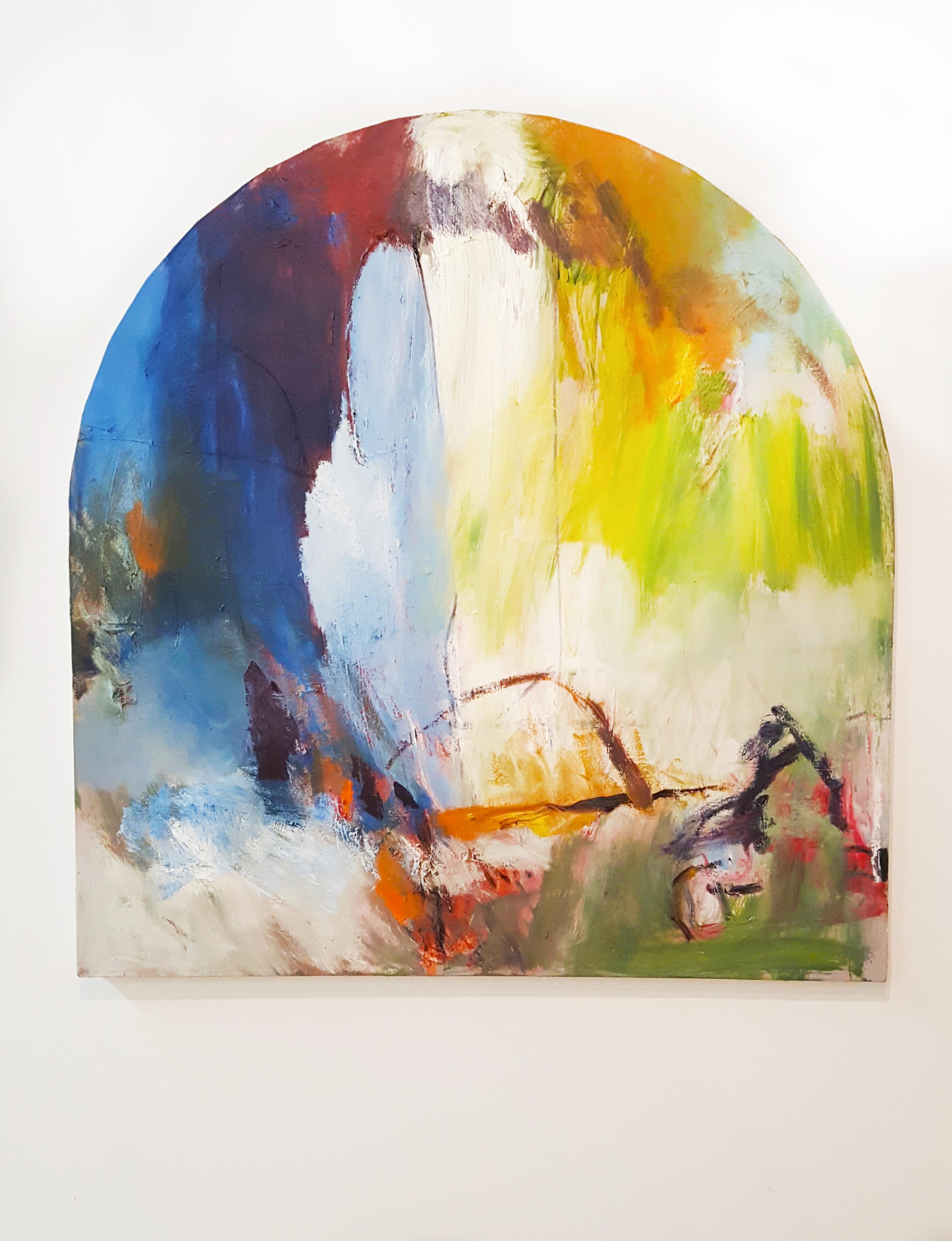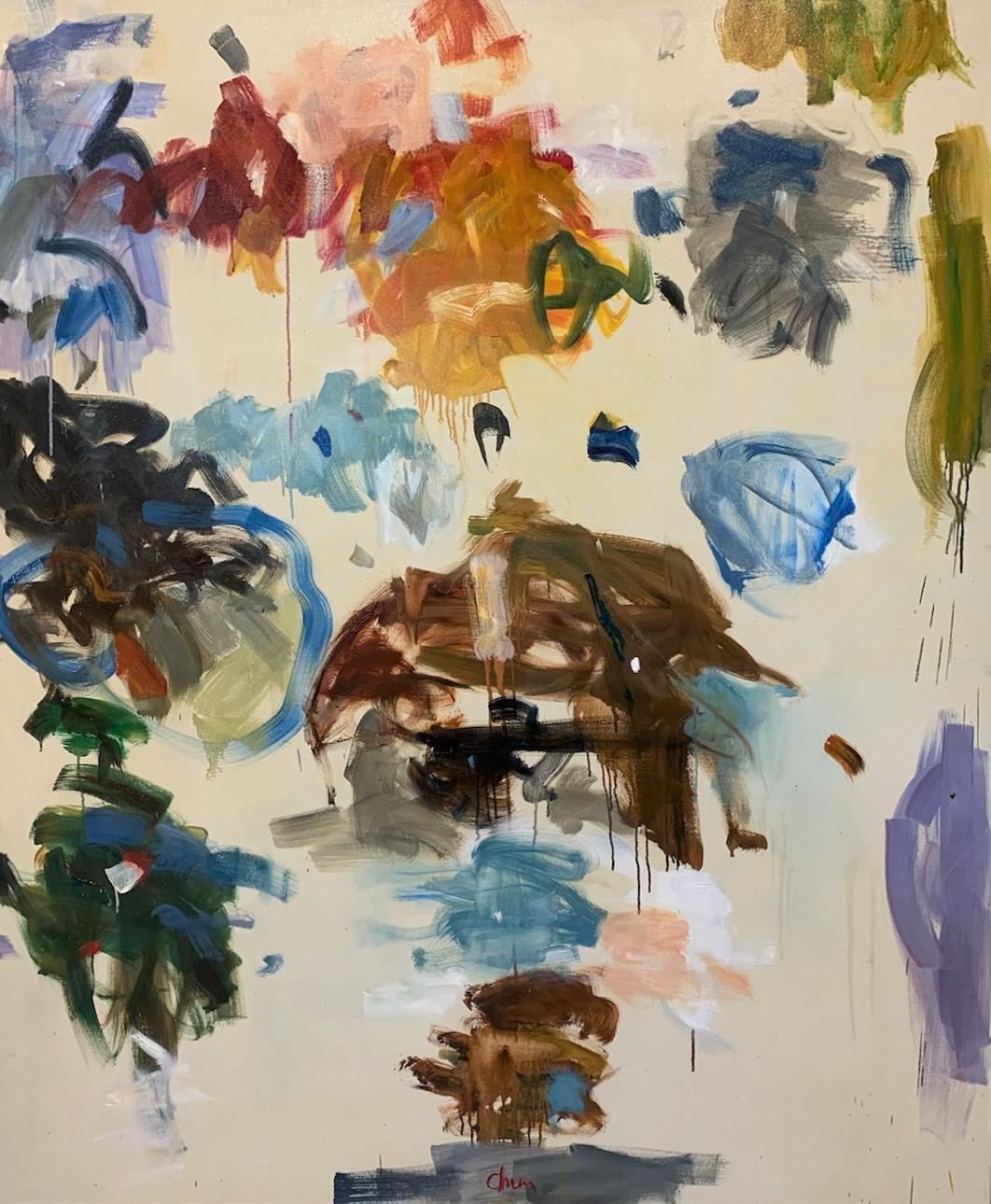Items Similar to 4-35 abstract oil painting by Charles Biederman
Want more images or videos?
Request additional images or videos from the seller
1 of 8
Charles Biederman4-35 abstract oil painting by Charles Biederman1935
1935
About the Item
Signed and dated "Biederman 4-35" lower right.
About this artist: Charles Joseph Biederman was a twentieth century abstract American artist best known for his constructivist, cubist-inspired reliefs. Biederman is often regarded as an American original, the self-proclaimed “best-known unknown artist in America.” Influenced by the aesthetic of Russian Constructivism and De Stijl, he dubbed his vivid geometric three-dimensional reliefs “New Art,” disregarding traditional mediums such as painting, drawing, or collage. Instead, he favored synthetic materials such as plastic and aluminum, most often coated with bright oil-based paint.
Regardless of his use of similar materials and aesthetic, Biederman’s work departs from the interests of De Stijl, Constructivism and Neo plasticism in his desire to depict the natural world, stripped to its most simplified and beautiful elements. Biederman’s work emphasizes line, transparency, light and shadow in his use of basic geometric shapes and symmetrical compositions. Initially inspired by the cubism of Braque and Picasso, his signature reliefs are regarded by scholars as a three-dimensional continuation of the cubists’ original interests[1]. While Picasso created the illusion of light and shadow through wielding a paintbrush, Biederman employed three-dimensional geometric shapes that create real shadows on the surface of the canvas. Biederman’s reliefs are not static, but constantly vulnerable to changes depending on the lighting conditions in which a relief is displayed, as well as the viewer’s relationship to and movement around the work. The temporal strategies of Biederman’s reliefs were also highly innovative—the artist made a conscious effort to bring a consideration of time into his work by forcing viewers to literally move their bodies and alter their point of views in order to experience the piece fully. An element of time and process is seen in Biederman’s unique system of labeling his work. Most of his reliefs are untitled, marked instead by two dates and the name of a city. The dates signify the time in which the preliminary drawing was executed and the second marks the date in which the work was fully realized. In his search for a New Art, Biederman became preoccupied with innovation. He was an artist concerned not with what was considered good or bad, but one who aimed to produce something that was truly unique and revolutionary.
Born in Cleveland, Ohio, Biederman grew fond of the visual arts at a young age. As a teenager, he enrolled in figure drawing and watercolor courses at the Cleveland Art Institute, and apprenticed at a local advertising agency, where he learned layout design. Despite failing to obtain a high school diploma, he later attended he Art Institute of Chicago from 1926 to 1929. While at school, Biederman began to explore various artistic influences and was immediately drawn to the early twentieth century European modernists, such as Picasso, Van Gogh, Seurat, and particularly Cézanne. Cézanne heavily informed Biederman’s early style, and his fascination with the artist is evidenced in both the visual and written work that he produced throughout his lifetime. Though professors celebrated his technical ability, Biederman failed to attend basic courses at the Art Institute. With no desire to complete his formal education, Biederman eventually left the school in 1929.
Biederman continued to paint throughout the Depression, experimenting with several styles reminiscent of the cubists and biomorphic surrealists. He often painted using discarded canvases and old flour sacks. Subsiding on little, he spent much of this time boarding with friends or sleeping on park benches, refusing to compromise his artistic talents for commercial work. During this time, he became acquainted with a brother of a classmate, John Anderson, who immediately took an interest in his art. Anderson soon became a close friend and patron. In 1934, Biederman left the Midwest for New York, to become established in the modern art scene of the city. During this period Biederman was featured in the show “Five American Constructionists” at Paul Reinhardt Galleries and had his first major solo exhibition at the Pierre Matisse Gallery in 1936.
In 1936, Biederman traveled to Paris where he met several European modernists including Joan Miró, Wassily Kandinsky, Piet Mondrian, Constantin Brancusi, Pablo Picasso, Georges Vantongerloo, and Jean Arp. His disillusionment with the artists’ personas and his growing discontentment with the medium of painting led him to return to New York where he kept to himself and continued to perfect his personal style of geometric reliefs[2]. By the late 1930s, Biederman had retired from the traditional medium of painting, and was working exclusively in structural reliefs composed of synthetic materials. Soon after, he began studying semantics with Alfred Korzybski in 1938, and was inspired to begin writing what evolved into his own interpretation of the history of Western art entitled, Art as the Evolution of Visual Knowledge, to be published a decade later in 1948. Unsatisfied with urban life and eager for an artistic reconnection to nature, Biederman soon returned to the rural Midwest. In 1941, Biederman moved to Chicago, where he reunited with and married Mary Katherine Moore, the sister of John Anderson’s wife. The two married in December of 1941 and started a home in rural Red Wing, Minnesota where Biederman could find inspiration in nature. Mary became essential to Biederman’s work as an artist and theorist; she provided the family’s primary source of income and assisted his written work through editing, translating, and conducting research.
The Walker Art Center in Minneapolis hosted the artist’s breakthrough show in 1965, and the Minneapolis Institute of Art showcased a Charles Biederman retrospective in 1976. Both shows helped to popularize his work throughout the United States, and solidify Biederman’s role in the development of American abstraction in the twentieth century. Unfortunately, Biederman’s wife passed away shortly before the Minneapolis Institute of Art show’s opening in 1975. Her death led to the artist’s reclusive lifestyle, and an unwillingness to cooperate with art dealers and patrons of the Northeast—which historians and scholars speculate cost Biederman his chance at art world fame and widespread recognition in the United States.
Throughout the 1980s and 1990s, Biederman’s work continued to show across the United States and abroad in Europe. In 1991, Biederman arranged to give the University of Minnesota over a thousand of his works, as well as selections from his personal library, correspondences, and written documents. The largest selection of his work remains in the Frederick R. Weisman Art Museum at the University of Minnesota. Despite declining eyesight, Biederman continued to create artworks until the mid 1990s. Despite his growing cynicism regarding the direction of the contemporary art world, Biederman remained dedicated to his written work in his final years. Until his death in 2004, he continued to publish art theory, often emphasizing the important role of nature and science in the creation of visual arts. The artist’s repertoire of written work consists of over a dozen books, and several articles published in renowned art periodicals such as ArtForum, The Structurist, and Studio International.
[1] Samuel Sachs, et al. Charles Biederman: A Retrospective. The Minneapolis Institute of Arts, page 9.
[2] Christopher Benincasa, “Why Charles Biederman Matters (To Me).” The Structurist, no 45/46.
by Lauren A. Zelaya
- Creator:Charles Biederman (1906 - 2004, American)
- Creation Year:1935
- Dimensions:Height: 15 in (38.1 cm)Width: 22 in (55.88 cm)
- Medium:
- Movement & Style:
- Period:
- Condition:
- Gallery Location:Hudson, NY
- Reference Number:
About the Seller
5.0
Vetted Seller
These experienced sellers undergo a comprehensive evaluation by our team of in-house experts.
Established in 1973
1stDibs seller since 2023
5 sales on 1stDibs
Typical response time: <1 hour
- ShippingRetrieving quote...Ships From: Hudson, NY
- Return PolicyThis item cannot be returned.
More From This SellerView All
- #2 (5) Abstract Oil Painting by Max SchnitzlerLocated in Hudson, NYThis painting measures 55 ¾" x 35 ½" and framed 57" x 37" x 1". It is hand-signed "Schnitzler" on the lower right. About this artist: Max Schnitzler (1903-1999) emigrated with his ...Category
Mid-20th Century Abstract Expressionist Abstract Paintings
MaterialsCanvas, Oil
- Environs of a Bridge oil painting by Seymour FranksBy Seymour FranksLocated in Hudson, NYHand-signed and dated "Franks 44" lower right. This work is in its original hand painted frame, made by the artist. The frame measures 29 ½" x 35 ½" x 1 ¾" and the canvas measures 26...Category
1940s Abstract Expressionist Abstract Paintings
MaterialsCanvas, Oil
- Deep as the Night oil painting by John Von WichtBy John von WichtLocated in Hudson, NYThis work is one of a group of over 100 works personally selected by the artist, and gifted to a close personal friend in 1969. Exhibited: 1967 National Academy Annual Exhibition -...Category
1960s Abstract Expressionist Abstract Paintings
MaterialsCanvas, Oil
- Flowers and Tears abstract oil painting by Hans BurkhardtBy Hans BurkhardtLocated in Hudson, NYStrong abstract painting by Hans Burkhardt. Hand-signed, titled and dated "Flowers and Tears 1968 / Hans Burkhardt" verso on canvas. Provenance: The artist to his daughter Elsa. By...Category
1960s Abstract Expressionist Abstract Paintings
MaterialsCanvas, Oil
- Abstracted pair of oil paintings by Carl HoltyBy Carl HoltyLocated in Hudson, NYThese works are only sold as a pair. Each painting measures 9" x 11" and framed 18" x 20.25" x 2.5" The red and gold work is signed "Carl Holty" in the lower right. About this artists: Carl Holty was awakened to his interest in art as a child through visits to the Layton Art Gallery of Milwaukee, and began painting lessons with Friedrich Wilhelm Heine at a young age. Though born in Freiburg, Germany, in 1900, he was raised in Wisconsin and enrolled at Marquette University. Before long, Holty abandoned his pre-medical studies in order to pursue art. He spent a summer at the School of the Chicago Art Institute in Saugatuck, Michigan, and set off for New York in 1920. He then studied at the National Academy of Design under Francis Coates Jones...Category
1940s Abstract Expressionist Abstract Paintings
MaterialsCanvas, Oil
- Subjective Farm Landscape abstract oil painting by Ralph RosenborgBy Ralph RosenborgLocated in Hudson, NYSubjective Farm Landscape 1940 Oil on canvas, 24" x 30" 37.5" x 31" x 2" framed - frame is original to this artwork Signed recto lower right: "rosenborg 40" & arrow box cypher. Signe...Category
1940s Abstract Expressionist Abstract Paintings
MaterialsCanvas, Oil
You May Also Like
- Medium Sized, Colorful, Women in Abstract Expressionism Oil Painting w/ SunsetLocated in Fort Worth, TXWomen in Abstract Expressionism: Colorful Sunset Inspired Artwork by Texas artist Winter Rusiloski. Details: Winter Rusiloski Cathedral, 2016 Oil on canvas 48 x 45" View works. Wind...Category
2010s Abstract Expressionist Abstract Paintings
MaterialsCanvas, Oil, Acrylic
- Blue TarpBy Oonju ChunLocated in Salt Lake City, UTBlue Tarp, oil on canvas, 60 x 50 in. (unframed, gallery-wrapped canvas). Oonju Chun’s large abstract expressionist paintings delightfully employ the basic...Category
2010s Abstract Expressionist Abstract Paintings
MaterialsCanvas, Oil
- Leap of FaithBy Oonju ChunLocated in Salt Lake City, UTLeap of Faith, Oonju Chun, oil on canvas, 40 x 40 in. (unframed, gallery-wrapped canvas), $4,900 Oonju Chun’s large abstract expressionist paintings deligh...Category
2010s Abstract Expressionist Abstract Paintings
MaterialsOil, Canvas
- Sunset Over MountainBy Oonju ChunLocated in Salt Lake City, UTSunset Over Mountain, Oonju Chun, oil on canvas, 60 x 50 in. (unframed, gallery-wrapped canvas), $7,200 Oonju Chun’s large abstract expressionist paintings...Category
2010s Abstract Expressionist Abstract Paintings
MaterialsCanvas, Oil
- Parallel ConstructionBy Oonju ChunLocated in Salt Lake City, UTParallel Construction, oil on canvas, 48 x 54 in. Oonju Chun’s large abstract expressionist paintings delightfully employ the basics of good, nonobjective ...Category
2010s Abstract Expressionist Abstract Paintings
MaterialsCanvas, Oil
- Oswaldo Vigas, Terricola, 1963, Oil on Canvas, 116 x 90 cm, 45.6 x 35.4 in.By Oswaldo VigasLocated in Miami, FLOswaldo Vigas Terricola, 1963 Oil on Canvas 116 x 90 cm 45.6 x 35.4 in. The painting is accompanied by a certificate of authenticity. Cat. Rais. 1963.131 Provenance: Private Collect...Category
1960s Abstract Expressionist Abstract Paintings
MaterialsCanvas, Oil




